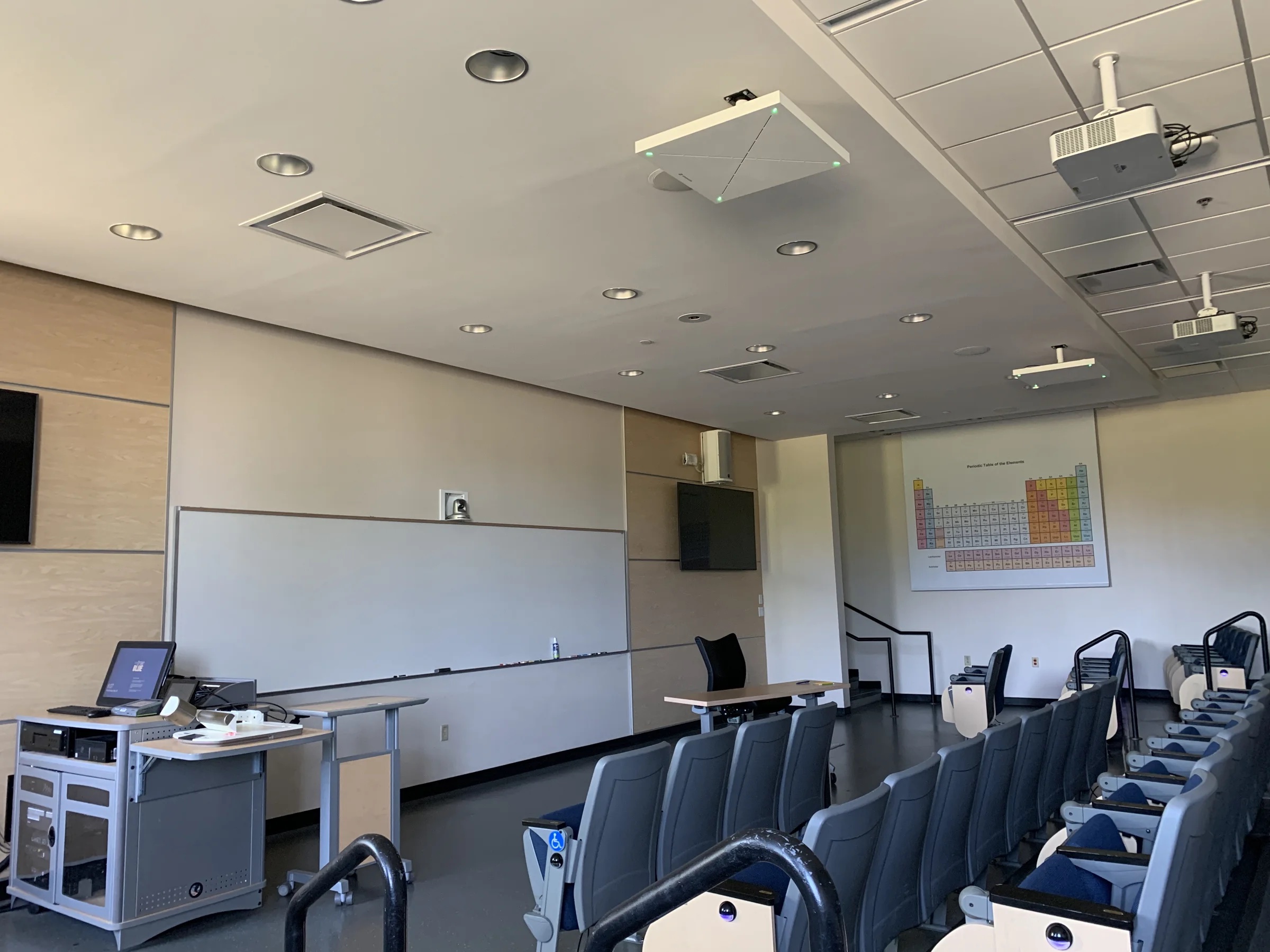Setting the Sound Standard – When Audio Matters
Middle Tennessee State University classrooms are outfitted with Sennheiser microphones to improve audio quality for hybrid students—making conferencing a breeze for faculty and leadership in the process.

The 500-acre Middle Tennessee State University (MTSU) is home to 20,000 students across 300 degree programs in eight undergraduate colleges, of which an estimated 80 percent of the student body attend classes in-person. Nevertheless, all classes are recorded and streamed for remote and hybrid participants via Panopto, making audio quality for all students, interoperability, and ease of use for faculty, key considerations for the AV and IT staff at the university.
After a few years of remote and hybrid classes, leveraging a camera and lanyard-style lavalier microphone for all classrooms, James Copeland, director of classroom technology at MTSU and his team realized they needed a better solution. “We quickly felt the pain of using battery-powered mics,” Copeland said. “There were issues with having the batteries regularly charged, so professors would come in and they couldn’t record their lecture because the mic was drained. If a class was over Zoom, the students couldn’t hear anything, so it was like the class wasn’t even happening.”
Beyond the challenge of remembering to charge the mic for the next educator, students wanted a better solution for collaboration. “Students in class wanted to communicate with their remote classmates, but did not want to physically pass a mic, and potentially germs,” Copeland said. “Logistically it was a natural transition to move to a ceiling microphone.”

Parity and Priority
The classroom technology department needed a better, easier-to-use solution across campus, with the provision that both the professor and students would be heard in a livestream or recording. Copeland and his colleagues Aaron Dill, classroom control system programmer, and Dustin Cunningham, classroom audio visual technician, landed on Sennheiser's TeamConnect Ceiling 2 for this sizeable project with support from a team of contracted integrators including Howard Technologies, M3, OneDiversified and TriStar Digital Connections.
The choice to go all in on 250 TeamConnect Ceiling 2s across MTSU’s campus was due to a few of the mic’s key differentiators. “The Sennheiser option was more ready out of the box [compared to competitors],” Copeland explained. “What caught my attention was the Priority Zone feature for professors.” The Priority Zone capability allows users to take full control of the speech in a room by setting a parameter in the space for the audio, enabling it to beam to focus on a specific location—for instance, the front of the room around the instructor’s area. This way, if there are side conversations happening across the room, the presenter or professor is not interrupted in the recording or livestream.
“We have classrooms where the tables and chairs are constantly reoriented. The beamforming mic benefits us here as well because you never know where everyone will be set up for a class.”
Aaron Dill
“We have classrooms where the tables and chairs are constantly reoriented,” Dill added. “The beamforming mic benefits us here as well, because you never know where everyone will be set up for a class.” The TCC2 features patented dynamic beamforming technology which picks up all audio in a room and uses digital signal processing to automatically locate and highlight the individual speaking, regardless of where they are sitting, standing, or moving. Voices are picked up evenly throughout the space, which is an important consideration if planning for a dynamic classroom setup or a professor with a collaborative teaching style.
Copeland and Dill manage 3,000 to 3,500 streams each day for class sections, relying on the TCC2s deployed across campus to capture the audio for each of these, with the Sennheiser Control Cockpit to oversee the mics from a centralized location. The Sennheiser ceiling microphones are integrated with MTSU’s Epiphan Mini video production systems in each classroom, as well as the Panopto recording and sharing platform. The TCC2 is also certified for Zoom, which is used by a few faculty members as part of their recording setup.
A daily selection of features, industry news, and analysis for tech managers. Sign up below.
[On Higher Ed Tech: Sennheiser]
Cross-Campus Benefits
Outside of the classroom use case, the TeamConnect Ceiling 2 microphones are also being used in conference room environments on campus. Specifically, these were selected for audio in the vice president and provost’s conference rooms, successfully enabling a natural and flexible audio experience for hybrid meetings happening amongst the university’s leadership and faculty.
Since the rollout of the TCC2s across MTSU’s sprawling campus, Copeland and Dill have received positive feedback from faculty and students. “All I’ve heard is how well it works and how easy it is,” Copeland said. “I used to get hundreds of tickets that there was no audio in a recording, because faculty would misuse the previous microphone solutions. This is no longer a concern thanks to the ceiling mics.”
Beyond the high-quality recorded audio, students and faculty also enjoy the intuitive mute capability of the TCC2s too. “Sometimes students will come up to a professor during class to talk about grades,” Copeland said. “The ability to easily mute the ceiling mics from the panel for such private conversations was a nice feature.”
In the future, Copeland plans to continue growing MTSU’s state-of-the-art AV and IT setup with Sennheiser. “The TeamConnect Ceiling 2 has become the new standard for us,” he said. “We have four new building projects we are currently designing for, and plan to use them as our microphones.”
The staff of AV Technology serves the community of decision-makers comprising AV/IT technology managers and directors, instructional technologists, and anyone making or influencing AV/IT technology decisions within their respective facilities and institutions.
